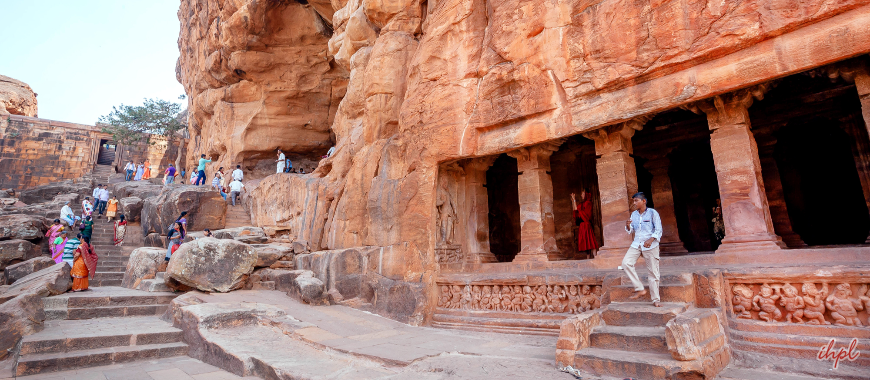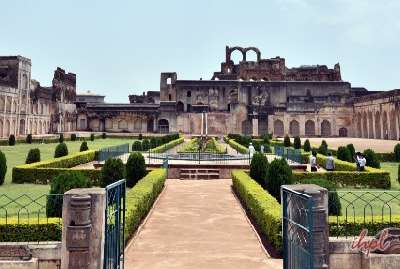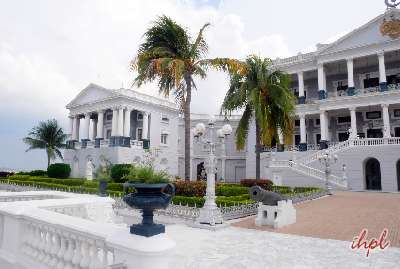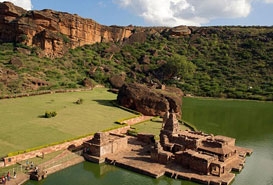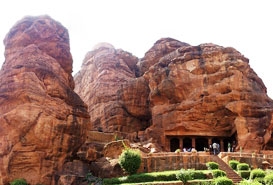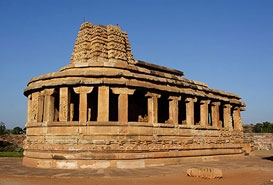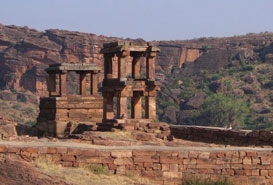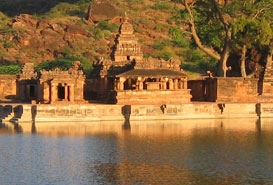Badami, the ancient capital of the Chalukyas, is famous for its rock-cut cave temples, serene Agastya Lake, and red sandstone cliffs. A haven for history buffs and architecture admirers. With 34 years of expertise, Indian Holiday brings you the best-customised tour packages and trusted local support, ensuring a journey as vibrant and diverse as Karnataka itself.
Still, wondering why Indian Holiday is your best choice? Read This: Why Choose a Travel Comp Over an Online Booking Agent? Is It Expensive To Book Through A Travel Company?
Placed on the banks of River Malaprabha in the Bagalkot district of Karnataka, Aihole many times is referred to as the ‘Cradle of Indian rock architecture’. This village, founded during the reign of the Chalukya dynasty, houses as many as 125 temples. Reflecting Buddhist and Jain styles of architecture, these temples are a proof of ancient rock-cut architecture style of India.
The Archaeological department has segregated these temples into 22 groups. If legends are to be believed, Aihole was the location where Lord Parshuram (an incarnation of Lord Vishnu) had cleaned his legendary axe after defeating the Kshatriyas.
Formerly known as Aryapur, it was the first capital of the Chalukya rulers. Later on, the capital was shifted to Badami that was then known as Vatapi.
Check out Karnataka tour packages, Bijapur tour packages, Sakleshpur Tour Packages, Jog Falls tour packages, Coorg tour packages
The rulers of Chalukya dynasty that erected these temples in different designs and Aihole was that place where they had done an experiment with the rock-cut architecture. Thus, Aihole is some also termed as the ‘laboratory of Chalukya architecture’. After gaining experience and success here, the rulers erected several temples in Pattadakal too.
The temples in Aihole were not built at once, but in several stages. While the first stage in which the temples were built, date back to the 6th century CE and the second stage was in the 12th century CE. The walls of these temples are adorned with several inscriptions, wherein some of them bate back to 643 CE. The inscriptions that are written in archaic Kannada and Sanskrit, tell the tales of victory and achievements of Pulakesi II over Harshavardhana.
Most of the temples were commissioned by Pulakesi II who was motivated by Jainism, explaining the inspiration of Jain style of architecture. Other than this, there are some temples that are inspired from Buddhist style of architecture.
The artisans showed their craftsmanship on the rock, combining both these architecture styles and came up with the Chalukya style of architecture. Plastered walls with inserted panels and curved towers with blind arches are representation of South and North Indian style of architecture respectively. The roofs, balcony and the sloops of the temple was inspired from Deccan architectural style.
The Galaganatha group of temples and the Kontigudi group of temples are the important ones from all the temples here. Lying on the banks of River Malaprabha, Galaganatha group comprises of 30 religious shrines where the Lad Khan temples is known to be the oldest one, dating back to the 5th century. Kontogudi group consists of 3 temples, namely the Lad Khan temple, Huchiappayyagudi temple and the Huchiappayya math.
The Chalukya rulers erected caves and shrines at other places like Pattadakal and Badami also. Apart from the temples, tourists can also look out for Ilkal, the traditional handloom and silk saris as well as Khadi garments. One can spot for handicrafts items such as elephants, gods and goddesses that are made from sandal wood. Some of the popular buys from here also include stone and metal carvings of gods and goddess.
Check out Luxury Karnataka Tour with Serai Hotels, Bandipur National Park tour packages,
Accommodation
Accommodation options at Aihole are very few. The town has a few budget hotels that offer basic facilities. There is also a tourist rest house that is run by KSTDC. In comparison to Aihole, Badami has better options in accommodation.
Food
Eating options too are limited in Aihole. Most of the restaurants here serve only vegetarian delicacies with South Indian cuisine being the predominant one.
Best Time to Visit
The best time to visit Aihole is between the months of October and March as the weather during this time is pleasant and ideal for sightseeing.
Check out Hampi tour packages, Hospet tour packages, Nagarhole National Park Tour Packages
Badami Tour Packages
Things To Do in Badami
Why Book With Us
35+
Years of Travel Experience
100+
Travel Experts To Assist You
03+
Million Satisfied Guests
Ministry
of Tourism Accredited
- 5/5 Rating:
- 4/5 Rating:

